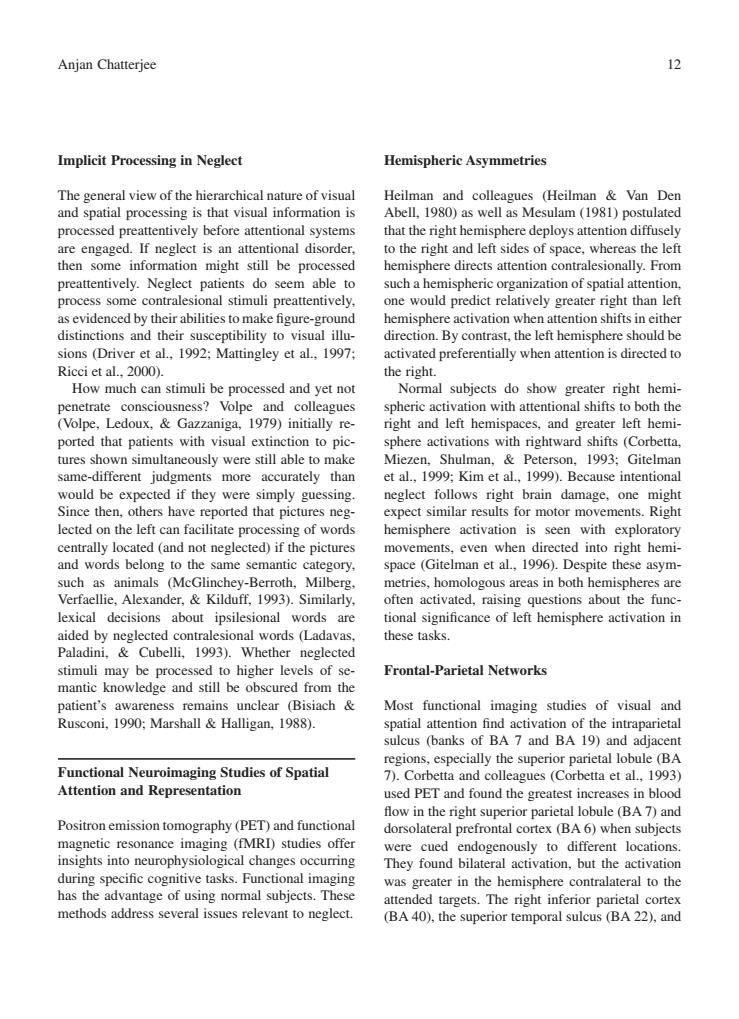正在加载图片...

Anian chatteriee Implicit Processing in Neglect Hemispheric Asymmetries The ge Heilman and colleagues (Heilman Van Den tial mation is Abell.1980)as vell a Me am1981) tulated sed p eaentively before l sys that the right hemisphe diffusely are engaged neglect is al diso rde rig left sides of spac the lef preattentively.Negl o seem ab ach a h uld pr spheric organ nof spatia es nake ngure activation the emisphere al 2000) much can stimuli be process the right ed and yet no do show greate right hemi Garraniga 1979) and initially re hemispaces porte that patients with exuncuon to pi sphere activations with rightward sh fts (Corbetta tures shown simultaneously were still able to make Miezen, Shulman,Petersor 1993:Gitelmar same-different judgments more accurately thar et al..1999;Kim et al.,1999).Because intentiona would be expected if they were simply guessing. neglect follows right brain damage,one might Since then,others have reported that pictures neg expect similar results for motor movements.Right lected on the left can facilitate processing of word hemisphere activation is seen with exploratory centrally located (and not neglected)if the pictures movements,even when directed into right hemi- and words belong to the same semantic category space (Gitelman et al..1996).Despite these asym- such as animals (McGlinchey-Berroth. Milberg metries,homologous areas in both hemispheres are Verfaellie.Alexander.Kilduff.1993).Similarlv often activated,raising questions about the func- lexical decisions about ipsilesional words are tional signifcance of left hemisphere activation in aided by neglected contralesional words (Ladavas. these tasks. Paladini,&Cubelli,1993).Whether neglected stimuli may be processed to higher levels of se Frontal-Parietal Networks mantic knowledge and still be obscured from the patient's awareness remains unclear (Bisiach Most functional imaging studies of visual and Rusconi.1990:Marshall Halligan.1988). spatial attention find activation of the intraparietal sulcus (banks of BA 7 and BA 19)and adiacent regions,especially the superior parietal lobule (BA Functional Neuroimaging Studies of Spatial 7)Corbetta and colleagues (Corbetta et al 1993) Attention and Representation used PET and found the greatest increases in blood owin theright parictal lobue (BA7ad Positron emission tomographv (PET)and functional dorsolateral prefro tal cortex(BA 6)when subjects magnetic resonance imaging (fMRI)studies offer were cued endogenously to different locat insights into neurophysiological changes occurring They found bilateral activation.but the activation during specific cognitive tasks.Functional imaging contralateral to the has the advantage of using normal subjects.These ts The right infer methods address several issues relevant to neglect. (BA40).the uperio d Implicit Processing in Neglect The general view of the hierarchical nature of visual and spatial processing is that visual information is processed preattentively before attentional systems are engaged. If neglect is an attentional disorder, then some information might still be processed preattentively. Neglect patients do seem able to process some contralesional stimuli preattentively, as evidenced by their abilities to make figure-ground distinctions and their susceptibility to visual illusions (Driver et al., 1992; Mattingley et al., 1997; Ricci et al., 2000). How much can stimuli be processed and yet not penetrate consciousness? Volpe and colleagues (Volpe, Ledoux, & Gazzaniga, 1979) initially reported that patients with visual extinction to pictures shown simultaneously were still able to make same-different judgments more accurately than would be expected if they were simply guessing. Since then, others have reported that pictures neglected on the left can facilitate processing of words centrally located (and not neglected) if the pictures and words belong to the same semantic category, such as animals (McGlinchey-Berroth, Milberg, Verfaellie, Alexander, & Kilduff, 1993). Similarly, lexical decisions about ipsilesional words are aided by neglected contralesional words (Ladavas, Paladini, & Cubelli, 1993). Whether neglected stimuli may be processed to higher levels of semantic knowledge and still be obscured from the patient’s awareness remains unclear (Bisiach & Rusconi, 1990; Marshall & Halligan, 1988). Functional Neuroimaging Studies of Spatial Attention and Representation Positron emission tomography (PET) and functional magnetic resonance imaging (fMRI) studies offer insights into neurophysiological changes occurring during specific cognitive tasks. Functional imaging has the advantage of using normal subjects. These methods address several issues relevant to neglect. Hemispheric Asymmetries Heilman and colleagues (Heilman & Van Den Abell, 1980) as well as Mesulam (1981) postulated that the right hemisphere deploys attention diffusely to the right and left sides of space, whereas the left hemisphere directs attention contralesionally. From such a hemispheric organization of spatial attention, one would predict relatively greater right than left hemisphere activation when attention shifts in either direction. By contrast, the left hemisphere should be activated preferentially when attention is directed to the right. Normal subjects do show greater right hemispheric activation with attentional shifts to both the right and left hemispaces, and greater left hemisphere activations with rightward shifts (Corbetta, Miezen, Shulman, & Peterson, 1993; Gitelman et al., 1999; Kim et al., 1999). Because intentional neglect follows right brain damage, one might expect similar results for motor movements. Right hemisphere activation is seen with exploratory movements, even when directed into right hemispace (Gitelman et al., 1996). Despite these asymmetries, homologous areas in both hemispheres are often activated, raising questions about the functional significance of left hemisphere activation in these tasks. Frontal-Parietal Networks Most functional imaging studies of visual and spatial attention find activation of the intraparietal sulcus (banks of BA 7 and BA 19) and adjacent regions, especially the superior parietal lobule (BA 7). Corbetta and colleagues (Corbetta et al., 1993) used PET and found the greatest increases in blood flow in the right superior parietal lobule (BA 7) and dorsolateral prefrontal cortex (BA 6) when subjects were cued endogenously to different locations. They found bilateral activation, but the activation was greater in the hemisphere contralateral to the attended targets. The right inferior parietal cortex (BA 40), the superior temporal sulcus (BA 22), and Anjan Chatterjee 12